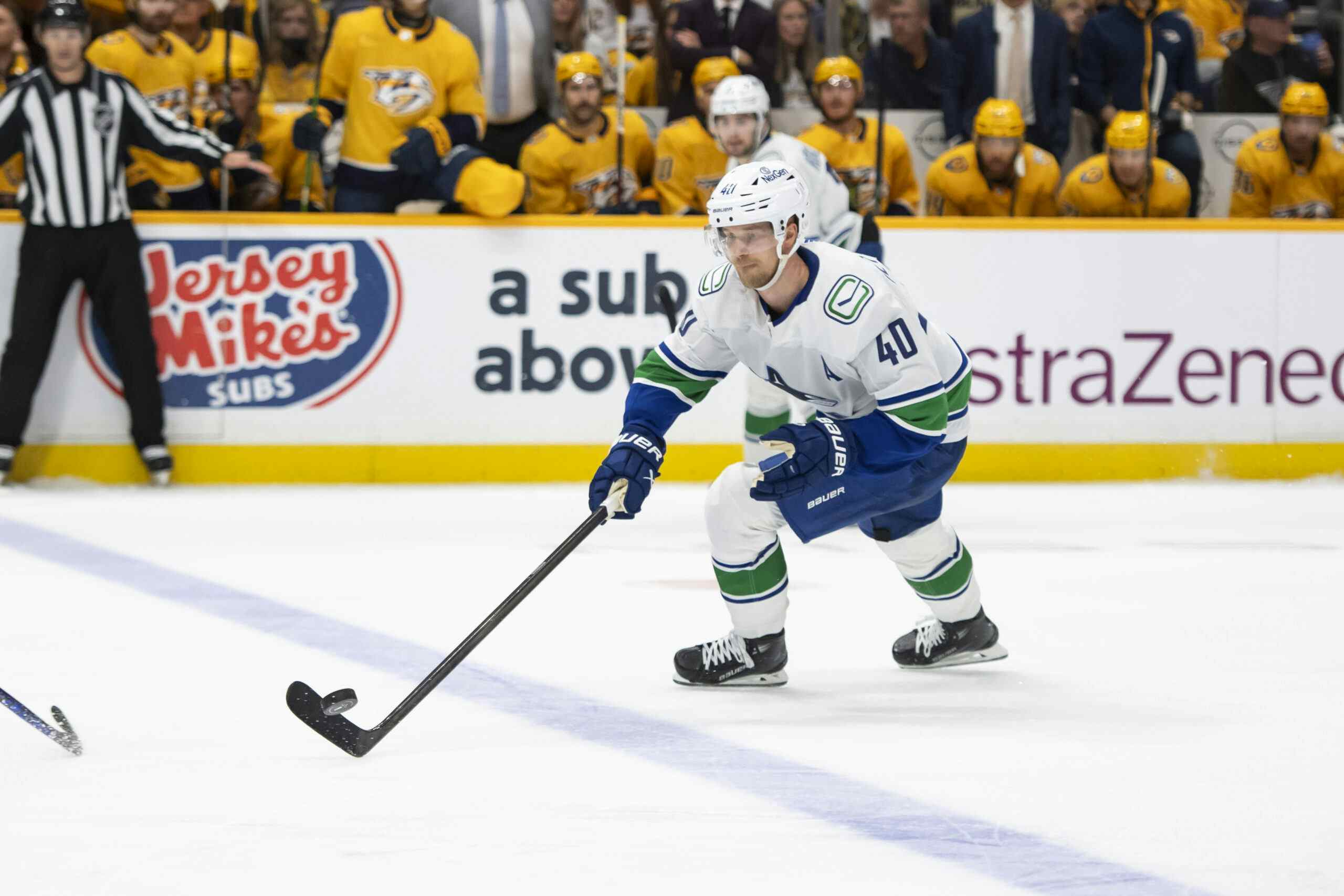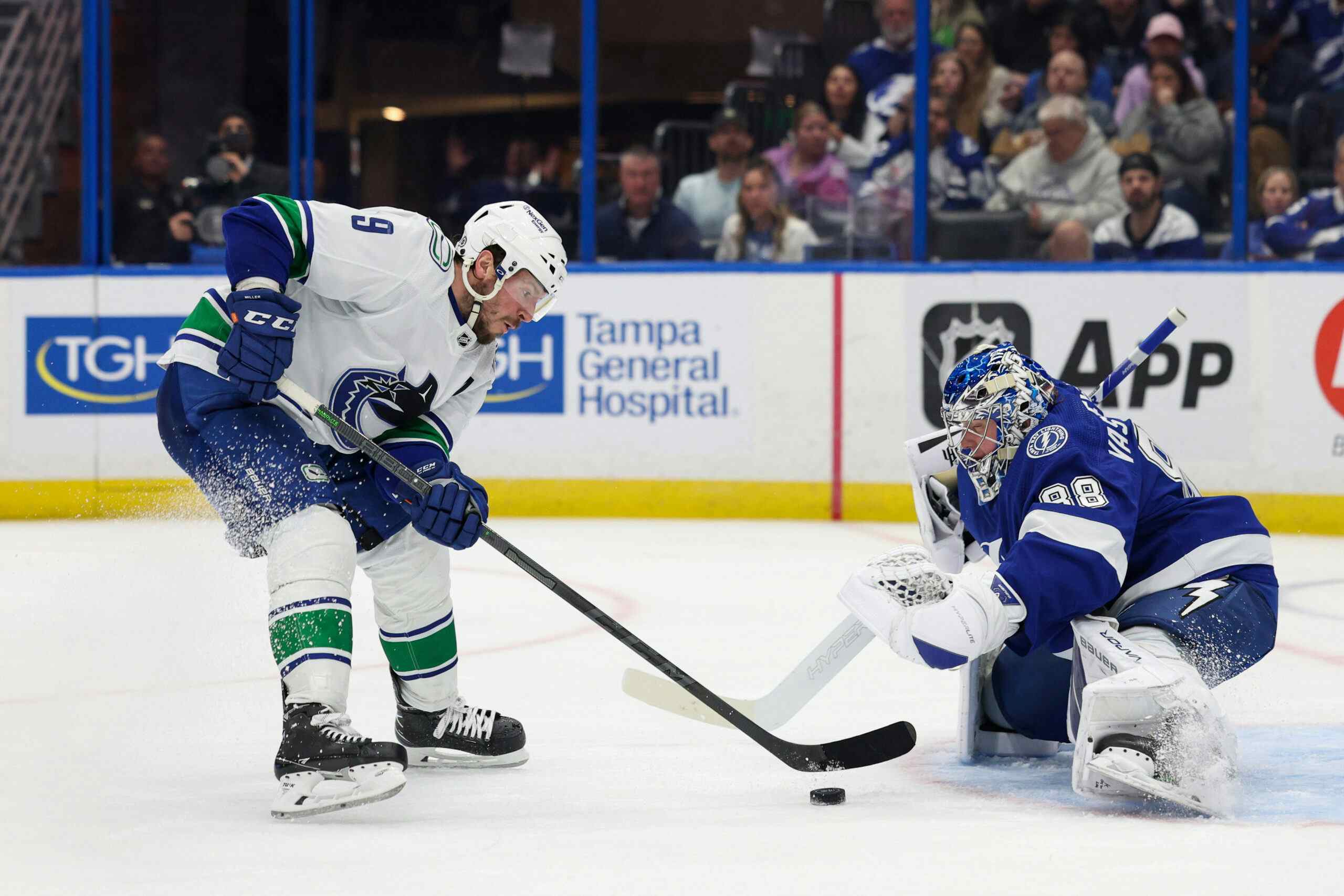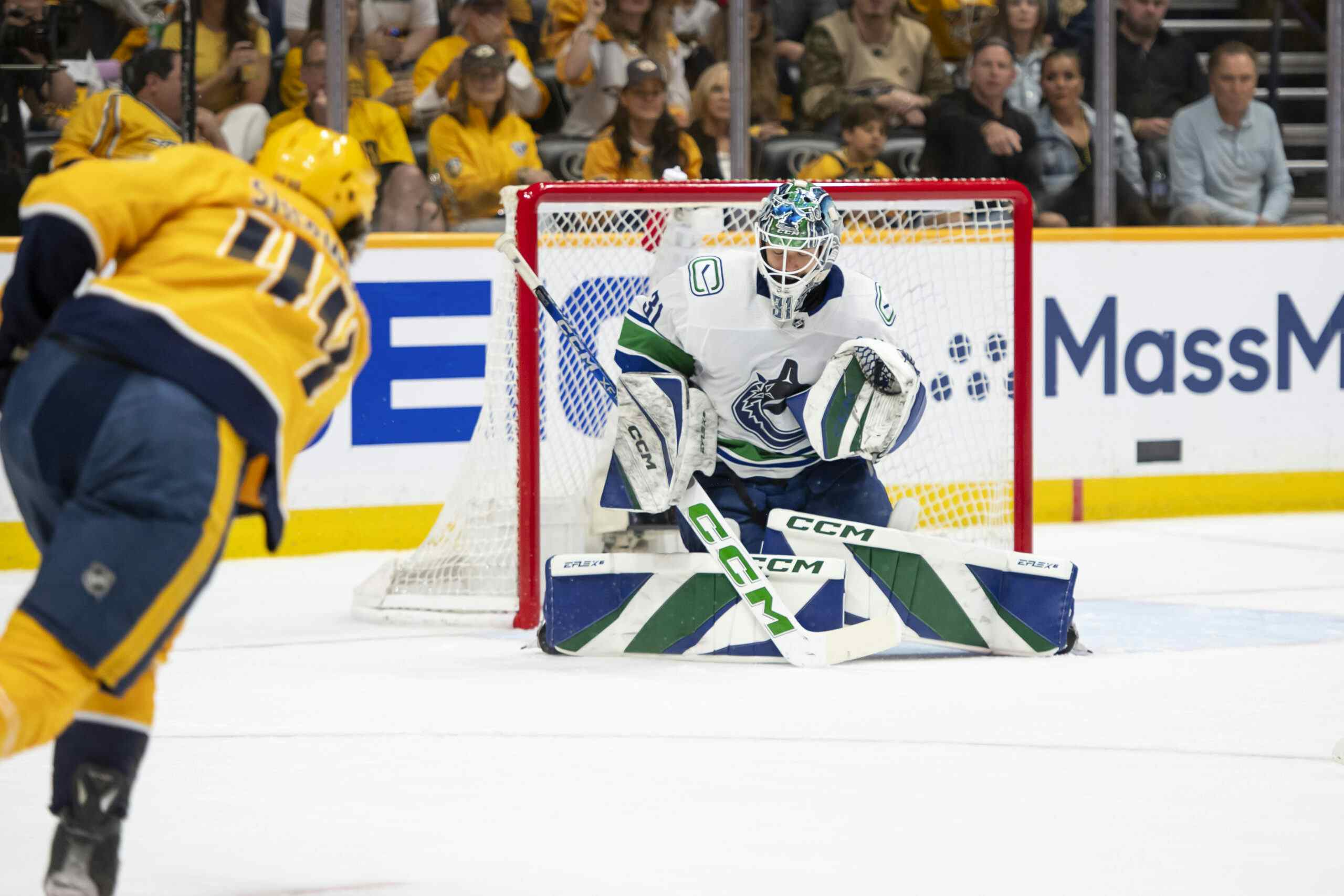How Do the Sedins Stack Up Against the NHL’s Best Dynamic Duos?
By Jeremy Davis
8 years agoIn light of Henrik’s return to the lineup, I thought I’d do a little statistical examination of the Sedins’ prowess as a duo. Jared McCann has filled in admirably, but Henrik and Daniel Sedin have know each other since about nine months before they were even born, and it’s hard to beat that kind of chemistry.
In their prime, the Sedins were the undisputedly the most dominant duo in the NHL. Years have past since their Art Ross seasons, but the Sedins have proven thus far to be resistant to the typical NHL aging process. At 35 years old, both are still near the top of NHL scoring – Daniel in seventh and Henrik in 16th.
There are always new duos in the NHL that combine to create magic and bury their opponents. Tyler Seguin and Jamie Benn of the Dallas Stars are currently the highest scoring duo in the league, though Patrick Kane and Artemi Panarin aren’t far behind. Youthful duos like Calgary’s Sean Monahan and Johnny Gaudreau, and Edmonton’s Taylor Hall and Leon Draisaitl have many years ahead of them still, but they’re already piling up the points.
So how do the Sedin twins, the best duo of days gone by, stack up against the league’s new wave of tandems? Read on for a statistical review.
I’ve chosen some of the NHL’s best pairs to compare the Sedins twins to. All of the duos in this group spend the majority of their time with each other, and typically rotate through third line members. Many of these pairs have already been working together for a while, while others have formed more recently. Let’s have a look at the duos in question.
Jamie Benn and Tyler Seguin (Dallas)
Benn and Seguin are currently the pair to beat in the NHL. Many traditional combos have a set up man and trigger man – this duo is not one of them. What makes Benn and Seguin so dangerous is that both of them are elite scorers, as well as fantastic playmakers.
Benn and Seguin are particularly interesting because neither of them came to the Stars in the way that elite players typically do. Victoria native Jamie Benn was a late round draft choice (129th overall) by the Stars in 2007. Tyler Seguin was a second overall pick, but came to the Stars in an offseason trade that saw Jim Nill absolutely fleece the Boston Bruins.
Patrick Kane and Artemi Panarin (Chicago)
Patrick Kane has already been a dynamic impact player in the NHL for a number of years, after being picked first overall in 2008. However, he has never been a threat to win the scoring race until recently. Last season he led briefly before being derailed by injury. This season, he’s been gifted an incredibly talented winger in Artemi Panarin, who has been called a miniature version of Kane himself.
Kane already has three Stanley Cups at the ripe age of 26, and after an off season marred by controversy in the wake of rape accusations, it’s hard to feel good about the Blackhawk star breaking out offensively.
Joe Thornton and Joe Pavelski (San Jose)
After the Sedin twins, no one on this list has played together more than Joe Thornton and Joe Pavelski. Big Joe and Little Joe have shared the ice for over 3,200 minutes at even strength alone since 2007-08, according to stats.hockeyanalysis.com.
Thornton is a former Art Ross Trophy winner and noted assist machine, but the 36-year old is finally starting to show signs of slowing down a fair bit. With only 20 points in 33 games, he has the lowest individual total of anyone on this list.
Johnny Gaudreau and Sean Monahan (Calgary)
Johnny Gaudreau and Season Monahan are magnificent to watch, and it’s shocking to think that they are in just their second and third years in the league respectively, yet they have already been bonafide first liners for over a year.
Offense aside though, Calgary young stars are still struggling on the defensive side of the puck, and it’s led to some unbalanced numbers in both possession and goal ratios. But with a combined age that is younger than Jaromir Jagr, these kids have plenty of time to figure that out.
Max Pacioretty and Tomas Plekanec (Montreal)
A pairing that we don’t get to see very much on the west coast, new Canadiens captain Max Pacioretty and noted turtleneck enthusiast Tomas Plekanec are the offensive engine for the NHL’s most storied franchise. This season they’ve been helped considerably by secondary scoring, and their personal numbers are tailing off of late.
Pacioretty and Plekanec have been among the chief reasons why Montreal hasn’t fallen apart in the absence of star goalie Carey Price, and the Habs can only get more dangerous once all of their stars are firing on all cylinders once again.
Vladimir Tarasenko and Alex Steen (St. Louis)
Forever a post-season disappointment, the St. Louis longed for a game breaker as they failed to meet expectations year after year. They finally have that player in Vladimir Tarasenko, one of the games best goal scorers. On top of that, he’s shown an ability to set up players as well, particularly in the October 16th game against Vancouver in which he led every player on the ice in primary passes that led to scoring chances.
Alex Steen has been Tarasenko’s most frequent linemate this season and the two have gelled into a danger combination that makes St. Louis a offensive threat every single night.
Taylor Hall and Leon Draisaitl (Edmonton)
The perpetually laughable Oilers have no shortage of offensive talent, and yet they’ve often had trouble manufacturing chemistry between their wealth of top draft picks. Leon Draisaitl, the Deutschland Dangler, began the year in AHL Bakersfield, but returned after the injury to phenom Connor McDavid. Since then, he and new found linemate Taylor Hall have been setting the world on fire.
Only Jamie Benn and Tyler Seguin, two of the league’s premier talents, are scoring at a higher rate than the pair of Hall and Draisaitl. It just goes to show, if you just keeping draft top five picks over and over, eventually you’ll two that can play well together.
Let’s take a look at how the Sedins match up against these duos when it comes to a variety of different statistics.
All WOWY stats have been gathered from Puckalytics’ SuperWOWY.
Time on Ice
The amount of time the duo has spent on the ice together in the 2015-16 season.
Before determining which duos are the most effective, it is important to establish which teammates count as duos. This problem has a pretty intuitive solution, as finding time on ice stats is a very simple process in this day and age.
In some cases, a team may have two star players who consistently rack up high point totals, finishing one and two in scoring on their team. One might erroneously assume that they are frequent linemates simply because they have the two highest point totals, when in fact they don’t play together very much at all. Pittsburgh’s Sidney Crosby and Evgeni Malkin are an example of this. Crosby and Malkin are easily Pittsburgh’s most talented players, and both have won multiple scoring races. However, they are both centres, and as such usually play apart from one another. This would not be an example of a duo.
To be considered a duo, the players should be spending the majority of their time together.

Shared Points
The number of team goals on which both players scored a point.
Another measure of how well two players connect is shared points. Shared points are team goals on which both players received a point.
The Sedins have long been adept at this, and this season is no different. Only Jamie Benn and Tyler Seguin have accrued more points on the same goals.

This is really no great surprise. The Sedins are not a rush scoring pair, except on two-on-ones which involve frequent passing. They prefer to grind opponents down and pull them out of position to manufacture prime chances. Rarely does a scoring chance occur when the Sedins are on the ice that both of them haven’t had a hand in.
Total Points
The total combined points between the players.
Rather than measuring how inseparable a pair of players is, total combined points tells you just how good they are, whether together or apart. Benn and Seguin sit at the top (where they usually are), while the league’s scoring leader and his rookie clone sit in second place.
In both Kane/Panarin’s and Hall/Draisaitl’s cases, the combined point totals are heavily influenced by one player over the other. Not so with the Sedins, who sit just a few points apart, despite Henrik missing a couple of games. Of all the duos, they are among the most similar to one another in terms of overall skill.

Percentage of Team Goals
The percentage of team even strength goals that the pair was on the ice for.
The percentage of team goals indicates to an extent how essential the duo is to their team. Of course, they might be somewhat skewed if the duo is simply scoring an outrageous amount of goals, as is the course with Benn/Seguin and Kane/Panarin.
In the cases of the Sedins however, the twins are posting more raw totals and still maintaining a high percentage of team goals because the rest of the team isn’t providing much offense. The Thornton/Pavelski combo is in a similar boat. The Pacioretty/Plekanec duo on the other hand has some fairly mediocre totals on a team that has received plenty of secondary scoring this season.

GF60
The duo’s shared on-ice even strength Goals-For per 60 minutes.
Rate stats measure the efficiency of players’ abilities. It isn’t always enough to just produce points, you have to be able to do it in a reasonable time frame.
Benn and Seguin are predictably at the top, and Kane and Panarin aren’t far back, but in between them is the relatively new duo of Hall and Draisaitl. They were put together a dozen games into this season, so the per 60 minute measurements put them closer to the pack than raw numbers do.
The Sedins’ 3.14 goals-for per 60 minutes is still a very respectable number, and demonstrates that they are maintaining a high level of scoring production even when there high ice time is taken into account.

GA60
The duo’s shared on-ice even strength Goals-Against per 60 minutes.
It’s not just important to score goals, it’s also important to keep them out of your own net. While the Sedin’s goals-for per 60 looks rather pedestrian compared to some of the young up-and-coming pairs, they’re goals-against per 60 is top notch. Only the Thornton and Pavelski tandem are getting scored on at a lower rate.
Benn and Seguin are also getting scored on relatively frequently and the Calgary duo of Monahan and Gaudreau is unsurprisingly bringing up the rear. This stat even gives the Montreal pair a chance to look good, rather sitting near the less ideal part of the graph.

GF%
The duo’s shared on-ice even strength Goals-For percentage.
The goals-for percentage metric weights both goals that the line scores on their opponents against goals that they allow while they’re on the ice. Since both are important, a higher rate is ideal. The Sedins were a bit behind some of the top duos in terms of goals for, but they’ve been extremely stingy with goals against. As a result, their one-ice goals ratio is among the best of the group.

CF%
The duo’s shared on-ice even strength Corsi-For percentage.
Goals are obviously the desired end result, but the process is also important. Possession metrics are an important determiner of future offensive production.
The Sedins are far below their most dominant possession years, but with a Corsi-For of 52.1 per cent, they’re still doing a strong job of controlling play. Measured against some of the best duos in the league, the twins are lagging a bit behind, but they are still kicking the crap out of Sean Monahan and Johnny Gaudreau, so there’s that.

It’s hard to get right to the bottom of why the Sedins’ GF% is so much more impressive than their CF%. Their on-ice shooting percentage (10.24 per cent) is actually lower than five of the seven other pairs, so their offensive luck is controlling the situation.
However, their on-ice save percentage (94.59 per cent) is easily the highest of the group, which is pretty surprising considering they’ve been playing in front of Ryan Miller (92.77) and Jacob Markstrom (93.57). This has earned them the highest PDO of the group at 104.8. Unfortunately, Puckalytics’ SuperWOWY does not show other metrics like Fenwick percentage or shot blocks, so it remains unclear if defensive play is also a strong factor.
CF60
The duo’s shared on-ice even strength shot attempts-for per 60 minutes.
One of the reasons that the Sedins’ Corsi-For percentage isn’t as high as some of the other duos’ percentages is that they aren’t generating near the output of shot attempts.

Their style of play may be hindering them to an extent here. They tend to focus on passing and establishing the cycle so intently that they spend an awful lot of time setting up shots rather than just throwing pucks at the net. This is not a criticism however, as they’ve made a career out of this. The tendency is to wait patiently for high quality chances to arrive, even if this sometimes means leading to zone entries that produce no shot attempts. The trade-off certainly seems to be worth it.
Age
The duo’s average age.
This isn’t a necessarily a measurement of a duo’s effectiveness, but it certainly is interesting. The Sedin twins, still among the league’s best players, are the oldest duo in this group. Which really makes their continued dominance all that much more impressive.

The fact that the Sedins are the oldest of the duos doesn’t exactly bode well for the future of the Canucks, but for the Sedins themselves, it’s just one more thing that makes them special.
Conclusion
To the surprise of few in Vancouver, the Sedins are still among the best dynamic duos in the league. They may no longer have the chops to compete with the Benns and Seguins and Kanes and Panarins of the league, but they are still without a doubt elite players.
The fact that the Sedins are still performing at this level in the twilight of their careers is obviously extremely impressive. Their numbers during their prime years were of course even more so. Shared statistics from their Art Ross seasons are strong enough to blow their current competition out of the water in both goals and possession.

The numbers here are good enough to top the charts above in Goals-For per 60 and Corsi-For percentage.
It’s certainly likely that these younger pairs will still grow and get better, but they have a long way to go to even come close to what the Sedins have accomplished as an NHL duo.
Daniel and Henrik Sedin are likely hall of famers and are among the greatest duos to ever play the game. They have certainly shared the ice more than any forward pairing in the last ten years, and perhaps more than any other pair of NHL players in the history of the league. Beyond just constantly being together, their constant and consistent production as a pair sets them up to be one of the greatest dynamic duos that hockey has ever known.
All statistics in this article are sourced from Puckalytics.com, stats.hockeyanalysis.com, and NHL.com.
Recent articles from Jeremy Davis





